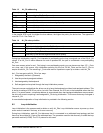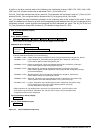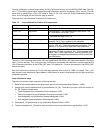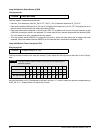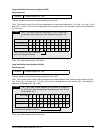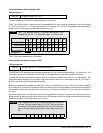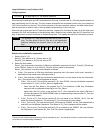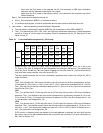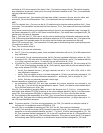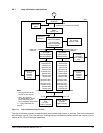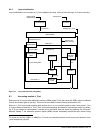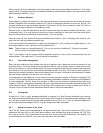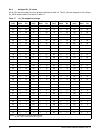
Fibre Channel Interface Manual, Rev. D 43
LISA
The L_Port primes the AL_PA bit map with the AL_PA bit map of the previous LIHA loop initialization
sequence. The L_Port sets the first available bit to 1 (unless a bit was set in LIFA, LIPA, or LIHA) which
corresponds to its soft assigned AL_PA. If a bit was available, the L_Port adjusts its AL_PA according
to which bit it set. If no bits are available, the L_Port remains in the nonparticipating mode; the L_Port
may attempt to re-initialize at the request of the node. If the L_Port does not support the AL_PA posi-
tion mapping loop initialization sequences, it sets byte 2 of the loop initialization identifier to 00h.
c. When the loop master receives the LISA sequence, it checks the loop initialization identifier value. If
the value is 11050100h, the loop master transmits two additional loop initialization sequences as fol-
lows:
LIRP
The L_Port sets the AL_PA position map to all hex ‘FF’, enters an offset of 01h followed by its AL_PA.
For example, if AL_PA = 05h, the AL_PA position map contains 0105FFFFFF...FFh.
LILP
The L_Port transmits the AL_PA position map of the previous LIRP loop initialization sequence.
d. When the last loop initialization sequence (identifier = LISA or LILP) is returned, the loop master trans-
mits CLS to place all L_Ports into Monitoring state. When the loop master received CLS, the L_Port
makes the transition to the Monitoring state and relinquishes its loop master role. At this time, all possi-
ble AL_PA values have been assigned for the number of L_Ports and every L_Port that has a valid
AL_PA is in participating mode.
If any frame is received that is not formatted according to figure 10, the frame is discarded and the loop master
restarts initialization at step 3b.
The loop master uses the E_D_TOV timer to wait for each of the above loop initialization sequences and the
CLS. If the timer expires before each transmitted loop initialization sequence of CLS is received, the L_Port
goes to the Initializing state.
The L_Port continues at step 5.
4. Non loop master L_Port—select unique AL_PA
A non loop master L_Port retransmits any received ARB(F0)s and prepares to receive (e.g. empties its
receive buffers) and retransmits the following LIFA, LIPA, LIHA, LISA, LIRP, and LILP loop initialization
sequences followed by CLS. The loop initialization sequences contain a 16-byte AL_PA bit map in the pay-
load. Each bit represents one AL_PA (see figure 10 and tables 16 and 13).
LIFA
The L_Port checks to see if the bit that corresponds to its fabric-assigned AL_PA is set. If it is not set to 1,
the L_Port sets the bit; if the bit is already set to 1, the L_Port assumes a soft-assigned AL_PA. The L_Port
retransmits the loop initialization sequence.
LIPA
The L_Port checks to see if the bit that corresponds to its previously-acquired AL_PA is set. If it is not set to
1, the L_Port sets the bit; if the bit is already set to 1, the L_Port assumes a soft-assigned AL_PA. The
L_Port retransmits the loop initialization sequence.
LIHA
The L_Port checks to see if the bit that corresponds to its hard-assigned AL_PA is set. If it is not set to 1,
the L_Port sets the bit (unless a bit was set in LIFA or LIPA); if the bit is already set to 1, the L_Port
assumes a soft-assigned AL_PA. The L_Port retransmits the loop initialization sequence.
To get the hard address, the drive must abort all Enclosure Services Interface (ESI) activity that may be in
process. Both ESI initiated by a receive or send diagnostic command and Enclosure Initiated ESI will be
aborted. Refer to Section 10.0 for more information on ESI.
LISA
The L_Port sets the first available bit to 1 (unless a bit was set in LIFA, LIPA, or LIHA above) that corre-
sponds to its soft-assigned AL_PA. If a bit was available, the L_Port adjusts its AL_PA according to which
bit was set. If no bits are available, the L_Port remains in nonparticipating mode; the L_Port may attempt to



